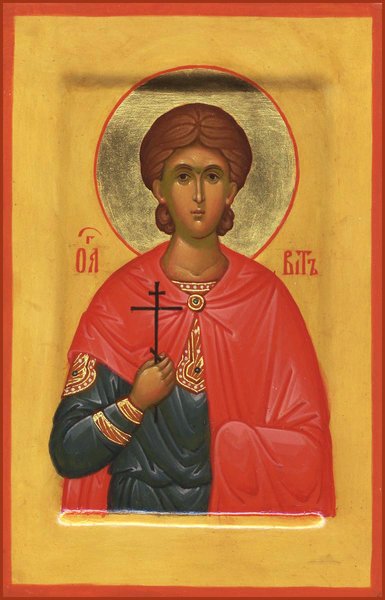Orthodox Saints of the Pre-Schism See of Rome

15th June
ABRAHAM of CLERMONT, St. Abraham was captured by a group of outlaws in Egypt and enslaved by them for five years before he was able to escape. He made his way to Europe, and settled as a hermit near Clermont in Gaul (France). At some point St. Abraham was ordained to the priesthood, and later was the Founding-Abbot of the Monastery of St. Cyriacus (monastère de Saint-Cirgues à Clermont) near present-day Clermont-Ferrand, France. St. Abraham reposed circa 480.
BENILDIS of CÓRDOBA, one of the Martyrs of Córdoba from the reign of Emir Muhammad I of Córdoba (r. 852–886), St. Benildis was so moved by the martyrdom of St. Athanasius of Córdoba (14th June) the previous day that she publicly proclaimed Christ, and the following day was burnt at the stake. Following her martyrdom in 853, St. Benildis’ ashes were thrown into the Guadalquivir river as was the case with many of her fellow martyrs.
CONSTANTINE of BEAUVAIS, a monk at the Abbey of St. Peter of Jumièges (abbaye Saint-Pierre de Jumièges) in Jumièges, Normandy (France), and disciple of its founder, St. Philibert of Jumièges (20th August). St. Constantine was later consecrated Bishop of Beauvais in Picardy (northern France). He reposed circa 706.
DOMITIAN and HADELIN of LOBBS, fellow monks at the the Abbey of St. Peter of Lobbes (abbaye Saint-Pierre de Lobbes), in present-day Belgium. At Lobbes they were both disciples of St. Landelin of Lobbes (vide infra). Both saints reposed circa 686.
EADBURH (EADBURGA, EDBURGH) of WINCHESTER, St. Eadburh, the daughter of Edward the Elder, King of the Anglo-Saxons (r. 899–924) and his third wife Eadgifu (Edith) of Kent (†c. 966), was placed in the monastery at Winchester England whilst still a child. During her life St. Eadburh was revered for the holiness of her life and renowned for her gentleness and humility. It is not known for sure, but she may have served as Abbess of the monastery at some point. St. Eadburh reposed in 960, and was buried in the Abbey church. In 972 some of her relics were translated to Pershore Abbey in Worcestershire, England, where many miracles are reported to have happened at her shrine.
LANDELIN (LANDELINUS) of CRESPIN, St. Landelin was a repentant robber who became a priest-monk. He founded several monasteries in present-day France and Belgium, beginning with the the Abbey of St. Peter of Lobbes (abbaye Saint-Pierre de Lobbes — Hainaut, Belgium) where he was the spiritual father of SS. Domitian and Hadelin of Lobbs (vide supra). St. Landelin also founded monasteries at Aulne (Belgium), Walers (France), and Crespin (France). St. Landelin reposed in 686.
MELAN of VIVIERS, Bishop of Viviers in the Languedoc (southern France) from 519 until his repose circa 549.
TRILLO (DRILLO, DREL) of WALES, St. Trillo, the son of a Breton chieftain, went to Wales with St. Cadfan (1st November). He is the founder and patron saint of the churches at Llandrillo in Gwynedd and Rhos-on-Sea (Llandrillo yn Rhos) in Conwy County Borough, Wales. St. Trillo reposed in the early part of the sixth century.
VITUS, MODESTUS, and CRESCENTIA, according to legend of dubious veracity, St. Vitus was the son of a Sicilian senator by the name of Hylas. St. Vitus was brought to Christ at the age of twelve by his nurse St. Crescentia and tutor St. Modestus. His conversion so enraged his pagan father that Hylas had SS. Vitus, Modestus, and Crescentia arrested, and scourged. The three saints managed to escape their captivity and flee Sicily, first to Lucania, then Rome. In Rome, they were once again arrested, this time on a charge of sorcery and failure to perform pagan sacrifices. Following torture, the saints were condemned to death circa 303. First, they were fed to lions, and when the lions refused to touch them, they were thrown into a vat of boiling oil.
For reasons no longer known, in sixteenth century Germany it was believed that dancing before a statue of St. Vitus on his feast day would give the dancer a years’ good health. In time, the dancing became so frenzied that onlookers thought the dancers were actually afflicted with the neurological disorder Sydenham chorea, which came to be colloquially known as ‘St. Vitus Dance’.
VOUGA (VOUGAR, VEHO, FEOCK, FIECH) of LESNEVEN, a sixth century bishop of an unknown diocese in Ireland. St. Vouga retired from his See, went to Brittany (France) and settled near Lesneven where he lived out the rest of his years as a hermit.
Prior to the Schism the Patriarchate of Rome was Orthodox, and fully in communion with the Orthodox Church. As Saint John of Shanghai and San Francisco +1966 said “The West was Orthodox for a thousand years, and her venerable Liturgy is far older than any of her heresies”.
Details of British Saints excerpted from Orthodox Saints of the British Isles.
Details of continental saints from these sources.
In many cases there are several spelling versions of the names of saints from the British Isles. I use the Oxford Dictionary of National Biography version as the primary version with the more prevalent version in parenthesis e.g. Ceadda (Chad) of Lichfield.

